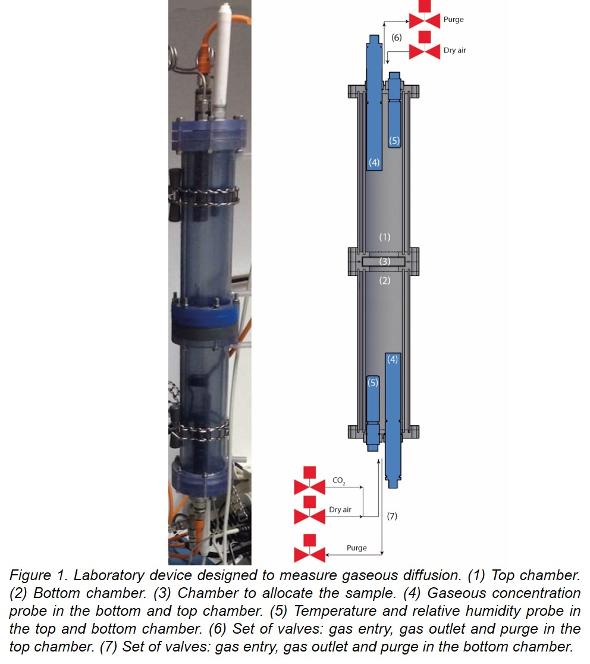Internationale Partnersuche
Innovation & Technologie Angebot
Laboratory-scale device to measure gas diffusion coefficients in real conditions
Country of Origin: Spain
Reference Number: TOES20170210001
Publication Date: 10 February 2017
Summary
A Spanish university has developed an automatic device to determine gas diffusion coefficients of single gases from a gas mixture under atmospheric conditions. It works in a wide range of relative humidity and temperature conditions. This non-destructive procedure allows to calculate the gas diffusion coefficients for permeable/porous material samples with different sizes and nature. The university is interested in licensing and technical cooperation agreements.
Description
Diffusion is the movement of a molecule in a gas mixture as a consequence of an existing concentration gradient and it constitutes the principal gas transport mechanism through porous materials. Diffusion is quantified through the gas diffusion coefficient (GDC) of the gas. In porous materials, this coefficient depends on the material type, its pore structure and its water content.
Although there are some different methods for measuring GDCs, most of them run under constant conditions, which cannot be modified. Thus, for example, temperature conditions or the volumetric water content in the samples cannot be varied during the tests. Therefore, the influence of some parameters, such us relative humidity or temperature, on the GDC cannot be properly established, despite being of paramount importance.
In order to solve the above mentioned problems, a Spanish research group has developed a device and a method that allow to determinate GDCs of, at least, one gas in a gas mixture (either, homogeneous or heterogeneous), when the gas moves through a porous or permeable material. The material can be tested under different conditions, such as the degrees of compaction (soils, rocks, concretes, synthetics materials, etc.), humidity and temperature. This device is able to reproduce real conditions at laboratory scale.
The sample is placed in a sealed cell between two differentiated vertical chambers. An automated injection of the gas under study is performed in one of the cells, keeping the gas concentration constant in this chamber during the whole procedure. Several probes for measuring the gas concentration, relative humidity and temperature are installed in each chamber. The diffusion process is well guaranteed due to the concentration gradient between the two chambers.
To determine the gas diffusion coefficient, the laboratory-scale device works following the gradient method. This method assumes that gas flow across the soil achieves a steady-state even though the gas concentrations in the chambers change over time. The device has an automatic control system to guarantee the experimental conditions set up by the user and a valves system, which allows the gas inlet and outlet (Figure 1).
This device has been designed in order to determine GDCs in a wide range of environmental conditions and for multiple samples with different size and composition (soils, rocks, concretes, synthetic materials, etc.). Thus, it could be useful for different applications, such us:
• Construction materials analysis.
• Geochemical gases prospection.
• Geochemical studies of the gaseous movement through soil and rocks.
Since this technology is protected under patent application, the Spanish research group is mainly looking for companies interested in the commercial exploitation of this invention through licensing agreement. However, the research team is also open to other technical cooperation agreements with companies in order to further develop the device at industrial scale, to adapt it to their necessities or to seek new applications.

Advantages and Innovations
The main innovative aspect of this device is that allows the calculation of the diffusion coefficient of a single or multiple gas components in a gas mixture, under different environmental conditions of humidity and temperature, reproducing real conditions. It determines the effect of the environmental parameters on the diffusion coefficient.
While, the main advantages of this technology are:
• It works with samples with different size and composition.
• It is a non-destructive test. The sample is not altered during the test.
• It is possible to test different gases simultaneously. For instance, water vapor (employed in the test to achieve the humidity required), and other gas as carbon dioxide (CO2), ozone (O3), methane (CH4), etc.
• It allows testing samples which cannot be tested in situ.
• It works in different modes: short and repetitive cycles, long cycles, etc.
Stage Of Development
Prototype available for demonstration
Stage Of Development Comment
The technology has been developed at laboratory scale, and the method has been proved to be reliable and reproducible enough. A prototype is available for demonstration (Figure 1).
Requested partner
- Type of partner sought: Companies
- Specific area of activity of the partner: Materials science, construction materials, geochemistry, geology.
- Task to be performed: Commercial exploitation of the technology; jointly collaborate to adapt the device to their particular requirements, to test it at industrial scale or help the research group find new applications.
Cooperation offer ist closed for requests

